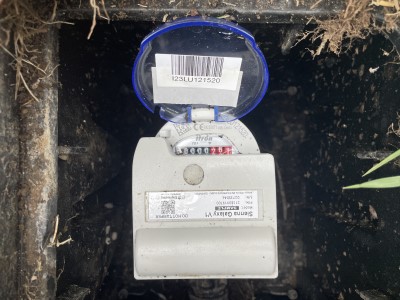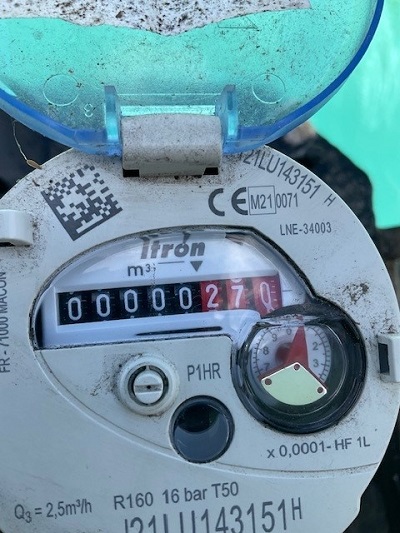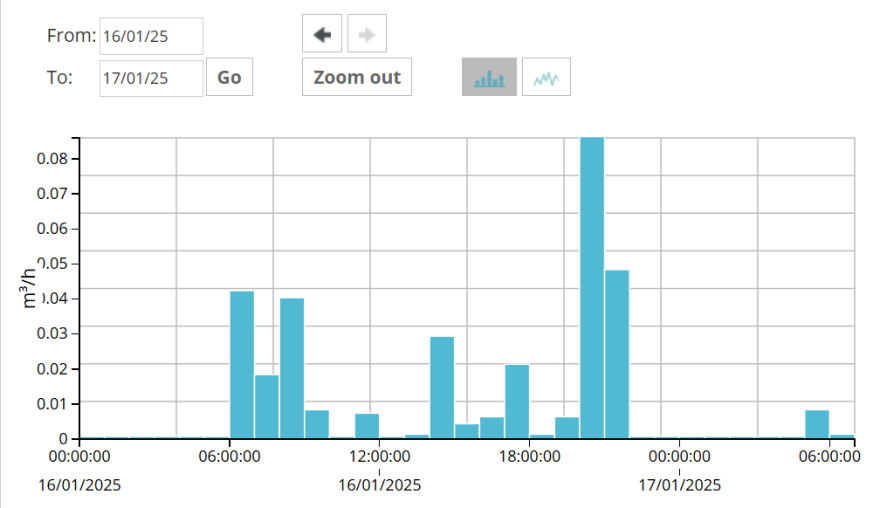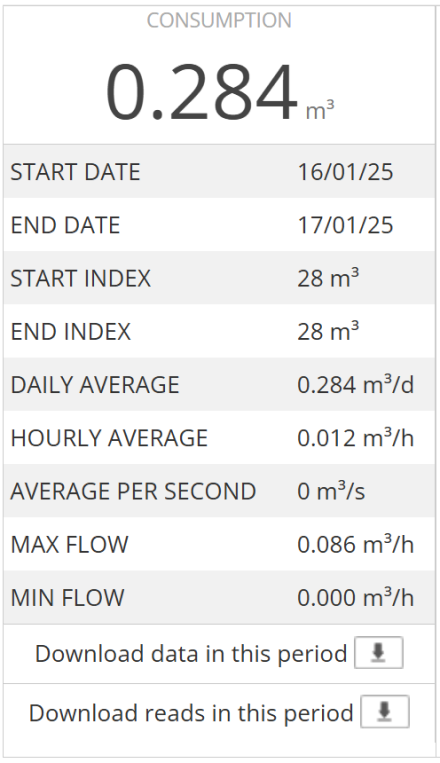Discover all you need to know about your water meter.
Got a remote water meter?
In September and November 2024, we upgraded the mechanical meters at some of our high water-using businesses to remote water meters.
A pilot to roll out remote water meters at homes in Windermere has taken place 2025.
Your meter will look like the picture below if you have a remote water meter. It has a small box on the top of it. Non-remote meters do not.
Find out more about the pilot roll out of remote water meters in Tauranga.

Got a mechanical meter?
Most households and businesses have mechanical, non-remote meters, like the image below.
Water meters record how much water your household or business is using. Water meters are located in a box in the ground, usually near your property's front boundary. The white numbers on the black background count your water usage in cubic metres (1000 litres). This is the reading your quarterly water invoice will be based on. The digits shown in red are not recorded by council when they read your meter.
For example the image below reads 00000.270 cubic metres (or 270 litres).

Water meter replacements
Water meters run slower and become less accurate over time. That’s why we replace and upgrade them on an ongoing basis across our city as our meters reach the end of their life.
If your water meter is due for replacement, a council employee will visit your property during business hours. You do not need to be at home, and there is no charge to you.
The work will take around 15-30 minutes and your water supply will be turned off during this time. If you are home, we will check first if it’s a convenient time before going ahead. Once the new meter is installed, we may need to enter your property to flush an outside tap for five to 10 seconds to get rid of any air or water discolouration. If you’re not at home, we’ll leave a card in your mailbox to let you know your water meter has been replaced.
If you have any questions, please call us on 07 577 7000.
Water meters on shared properties
If you share a driveway or live in a block of flats, there will likely be a primary water meter at the roadside boundary (measuring all the water entering the property) and then additional meters for each dwelling.
Council is responsible for most meters but property owners are responsible for the pipes that connect these meters. If a leak is discovered, it is up to the property owners to resolve it and pay for repairs to these private pipes.
Remote water meters
Remote water meters give more detail about your water use, helping you save water and manage your water bill.
A remote water meter measures use, providing access to regular hourly data each day. They can also help detect issues with both the water connection and usage on the site, detecting leaks early, backflow events, and high and low usage based on historic trends at your place.
Data from the meters in the pilot programme in Windermere is transmitted through a unit attached to the meter, and can be viewed on a dashboard. This helps users to understand how much water is being used. It is not collecting other data, such as personal information, and is a separate system from Wi-Fi and public broadband.
Council will be receiving the data from the remote meters in Windermere regularly, meaning we can audit the data to ensure its accuracy.
Remote water metering is a new initiative across New Zealand but is well established internationally. Tauranga is going to be rolling out various small remote water metering initiatives in 2025 as part of the discovery phase of an upcoming business case around potential city-wide remote meter deployment.
If you have a remote water meter, and you're wondering how to read your dashboard, check out this video.
Remote meter frequently asked questions
Following the installation of remote meters in March, you should have now received your first bill. We acknowledge your latest water rates invoice may have covered a longer period than normal, which might therefore have resulted in a higher charge than you may have been expecting. We appreciate this may have been unsettling. Please contact us if you need any additional time to pay this invoice, to ensure no late payment penalties are applied.
Logins are provided to the homeowner, or business owner. If you are renting your home and would like to see your usage, please speak to your landlord or property manager.
The login will only allow you to see your data, no one else's.
Once you have been sent a link to log in, click on your address. This will take you through to a new webpage, which shows you a consumption table and a bar graph. Examples of what these look like are below.
The bar graph will show you how much water you’re using over a specific time period. See an increase? That might be from your shower or washing machine.
You can change the way the graph looks, and the period it covers, by changing the boxes above the graph.

The consumption table gives more detailed information on your usage for your chosen time period.
The maximum and minimum flow readings represent the highest points and lowest points of the graph.
Water use is measured in cubic metres (m3). For reference, 1m3 is equivalent to 1000 litres (L). The start and end index readings in the table align with the start and end date your graph is showing. The index reading is also what appears on your water meter. If you're looking at a short timeframe, such as a day, you are not likely to see your index readings change much as 1000 litres of water would need to be used before this number increases.

Once you have access to your dashboard, you can review your water use data by the hour. If you see water usage at times when it is unexpected, for example overnight or when you are out of the house, you may have a leak. An example of what you may see if a leak is present is below:
This data shows a leak. See at the bottom of the data table the minimum flow for this two-day period is 0.043m3/h (43 litres per hour). We would expect this reading to be zero, as there will be times when you are out the house or overnight when you are not using water.

If you suspect you have a leak you can also check at your meter. Water meters are located in a box in the ground near your front boundary. The white numbers on the black background count your water usage in cubic metres (1000 litres). The white numbers on the red background count your water usage in litres. If the number wheels are turning when all your taps are turned off in the house, you may have a leak. If the leak is slow the number wheels may be moving very slowly so it may help to take a photo of the meter and return 10 minutes later to check if the numbers have changed and by how much.
For further information if you suspect a leak, visit the water leak information webpage.
The only data being recorded is your water use. It is not collecting other data, , the uses a separate communication system from Wi-Fi and public broadband.
This data is being kept in accordance with TCC's Privacy Statement.
No, we don’t. Your water meter is in a box near your front boundary. However, we will need to temporarily shut down your water for about five minutes while we change the meter.
No. It will enable you to see your water use, and if you would like to, identify ways to manage consumption and therefore, cost. The water data is transmitted to our office daily to inform billing. It also means we can audit data regularly to make sure it is accurate.
Council, as we are responsible for all water metering. This is the same as with mechanical meters, which our team upgrades and replaces as required.
Some do. Auckland is in the process of updating its mechanical meters to remote water meters currently, while Wellington and New Plymouth are installing metering for the first time, with remote meters being made standard. Internationally, remote metering has been adopted as standard practice for metering fleets.
The average person uses approximately 180 litres per day. You can read more about this in our water supply dashboard.